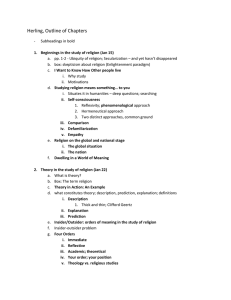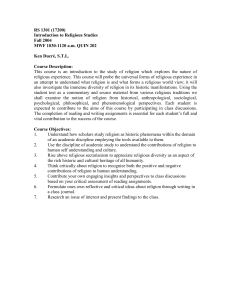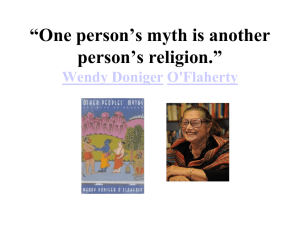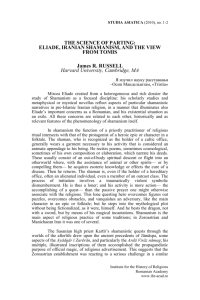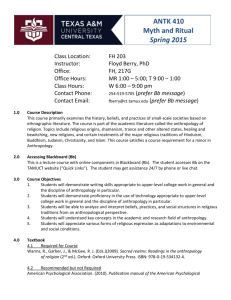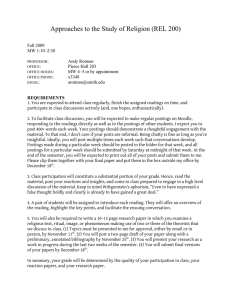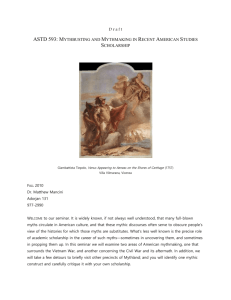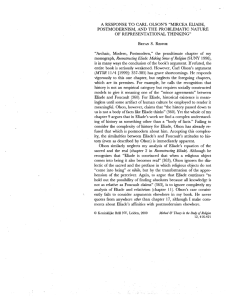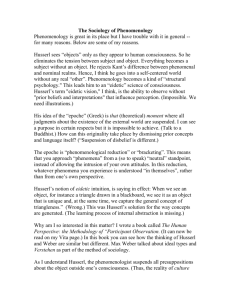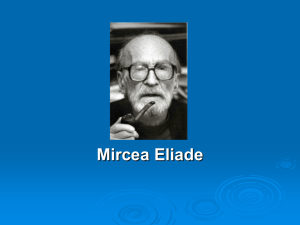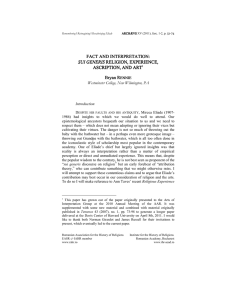Drawing the Theorists' Eye:
advertisement
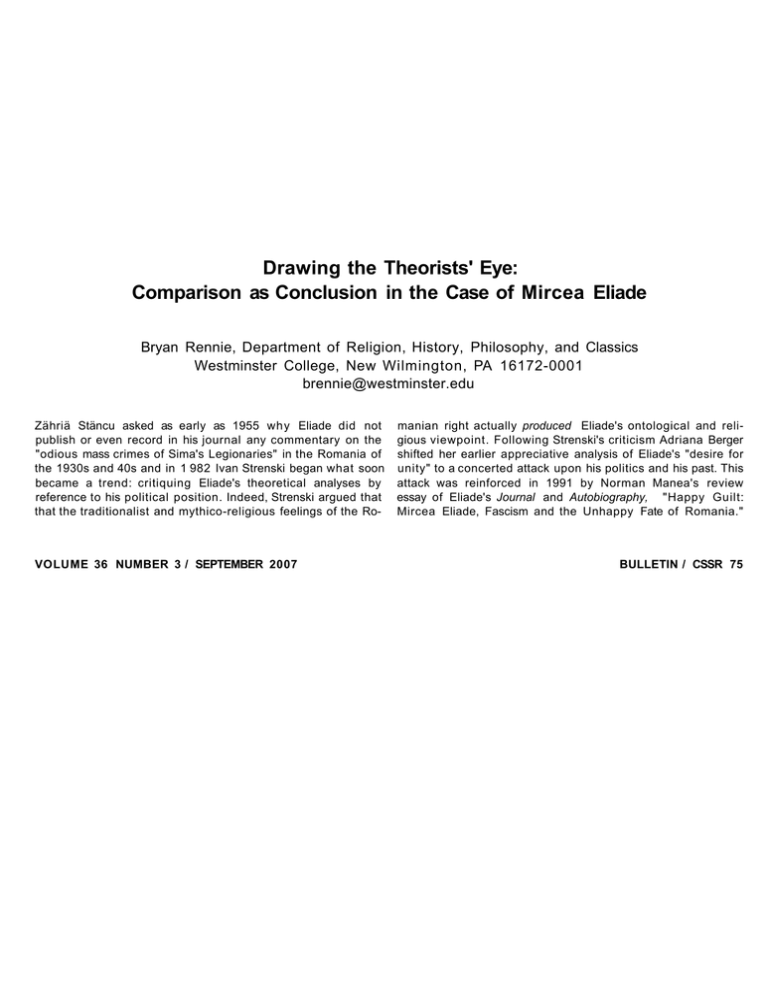
Drawing the Theorists' Eye: Comparison as Conclusion in the Case of Mircea Eliade Bryan Rennie, Department of Religion, History, Philosophy, and Classics Westminster College, New Wilmington, PA 16172-0001 brennie@westminster.edu Zähriä Stäncu asked as early as 1955 why Eliade did not publish or even record in his journal any commentary on the "odious mass crimes of Sima's Legionaries" in the Romania of the 1930s and 40s and in 1 982 Ivan Strenski began what soon became a trend: critiquing Eliade's theoretical analyses by reference to his political position. Indeed, Strenski argued that that the traditionalist and mythico-religious feelings of the Ro- VOLUME 36 NUMBER 3 / SEPTEMBER 2007 manian right actually produced Eliade's ontological and religious viewpoint. Following Strenski's criticism Adriana Berger shifted her earlier appreciative analysis of Eliade's "desire for unity" to a concerted attack upon his politics and his past. This attack was reinforced in 1991 by Norman Manea's review essay of Eliade's Journal and Autobiography, "Happy Guilt: Mircea Eliade, Fascism and the Unhappy Fate of Romania." BULLETIN / CSSR 75 Manea spoke of "the fact of Eliade's nationalist affiliation, its magnitude and its durability" and insisted that "during the years of his connection with the Romanian fascist movement ... Eliade always avoided a clear analysis of his militancy" (36). Later, in a review of the journal of Eliade's Jewish onetime friend, Mihail Sebastian, Manea details their estrangement because of Eliade's politics and his "involvement with the anti-Semitic Vremea," a weekly newspaper (1998, 38, and see 2003, 120). At about the same time Leon Volovici published Nationalist Ideology and Anti-Semitism, The Case of Romanian Intellectuals in the 30s, which gave extensive coverage to the case of Mircea Eliade. However, probably the most virulent attack on the influence of right wing politics on Eliade's understanding of religion came in 1993 from the French scholar, Daniel Dubuisson. I responded in some detail to Strenski, Berger, Volovici, and Dubuisson in chapter 13 of my Reconstructing Eliade (1996). Shortly after this, Russell McCutcheon argued that the kind of scholarship of which Eliade was the chief exemplar falsely claimed to be "apolitical." It thus produced a "study of religion ... isolated from issues of power and privilege," which, among other evils, allowed Eliade to avoid responsibility for his own nationalist past and to gain power and privilege in his discipline (1997, 179). Add to this the work of Steven Wasserstrom on Eliade's correspondence with selfstyled superfascist, Julius Evola (1999, 49, 89, 101) and one has a considerable body of material proposing a very negative evaluation of Eliade's political position. However, the case is far from closed. The detailed responses of Mac Linscott Ricketts (2003) must be taken into account, and the defense of Eliade mounted by Francis Ion Dworschak (2004) is also wellworth considering. Florin Turcanu's Mircea Eliade: Prisonnier de l'Histoire (2003) paints a more complex and nuanced picture of Eliade's life and times. Recent conferences in Bucharest in September 2006 and in Chicago in November of the same year show Eliade in a much more complex light. The scholars attending the conference at the Martin Marty Center in the University of Chicago's Divinity School represented the whole spectrum of analyses of Eliade. They included Daniel Dubuisson, Steven Wasserstrom, the extremely knowledgeable Romanian Jewish scholar Moshe Idei, as well as Matei Calinescu, Antoine Faivre, Carlo Ginzburg, J. Z. Smith, Bryan Rennie, and Florin Turcanu. The proceedings of this conference are soon to appear in a volume from Oxford University Press (Doniger and Wedermeyer, forthcoming). The general conclusion of both these conferences was that the more extreme positions which have been taken on Eliade are probably mistaken. Both his politics and his personality were complex and overly-simple accusations (and exonerations) appear unwarranted. The younger scholars who are currently graduate students at the University of Chicago seemed to represent a tendency to return to the Eliadean corpus with renewed appreciation and an unbiased eye, although not without caution. Nonetheless, the comparisons made in the earlier, more critical literature were numerous and are still instructive. Adriana Berger, in her former period of sympathy for Eliade compared him with Henri Corbin as scholars who "revived a positive notion of the imagination" (1986, 141). Later, however, Berger compared Eliade to Kurt Waldheim, Herbert von Karajan, Martin Heidegger, and Paul de Man. Ansgar Paus and Russell McCutcheon both compared Eliade to Rudoph Otto, 76 BULLETIN / CSSR to elucidate their understanding of Eliade's "sacred" via Otto's Das Heilige. In sharp distinction to this William Paden argued that Eliade's idea of the sacred is more closely comparable to le sacré of Emile Durkheim (1994). McCutcheon has also compared Eliade to Heidegger and de Man, although not without qualifications. He says, "I see the links between the Eliade, de Man, and Heidegger affairs not in terms of any similarity in their individual actions, beliefs, or guilt... rather, the links pertain to the techniques their contemporary defenders use not only to protect their work and influence in academia but to construct and maintain a supposedly ahistorical, totalized scholarly field" (2002, 43). Norman Manea, on the contrary, has written repeatedly and insistently on Eliade's culpability as an anti-Semite and supporter of the fascist Iron Guard, and he compares Eliade to Nae lonescu, Constantin Noica, and Emil Cioran without any qualifications. Leon Volovici makes these same comparisons and adds various other names to the list: Robert Brasillach in France, Nicolae Ro§u and Nichifor Crainic in Romania. All of these men voiced explicit and enthusiastic support for Nazi and fascist regimes, and even though Volovici recognizes that, unlike them, Eliade "avoided declaring his sympathy with Nazism in public" (1991,131,135), Eliade is nonetheless counted amongst their number. Volovici admits in his conclusion that Eliade's "case" is "more complicated" (191). Nonetheless his comparisons stand. Steven Wasserstrom concluded his comparison of Eliade and Evola conclusively to prove Julius Evola's substantive closeness with Eliade (1999, and see Rennie, 2003). I have argued elsewhere that "[¡Interpreting Eliade has become a microcosm of the History of Religions itself" (1996, 1-2). Continuing this comparison of the study of Eliade to the study of religion, I would like to consider briefly some questions about comparativism in Religious Studies before considering its particular application in Eliade's case. In a paper on comparativism Wendy Doniger pointed out that the essence of prejudice can be seen as "the assumption that an unknown individual has all the characteristics of the group to which he or she belongs" (1996, 539). This type of prejudice is at work when Eliade is grouped with Cioran, Heidegger, or Evola. Eliade's less obvious political affiliations are explained as resembling those of some figure whose position is more familiar or more self-evident and he is assumed to have all of the characteristics of a class in which he can be included for other reasons. In a useful article on comparative studies, Fitz John PorterPoole has pointed out that "[t]he comparability of phenomena always depends both on the purpose of comparison and on a theoretically informed analysis" (1986, 414-15) and that "various constructions and mappings tend to set different perspectives and to serve different analytical purposes by emphasizing varied aspects of the concept or domain" (432). In presenting a methodological framework for comparative study and applying Bertrand Russell's theory of logical types to comparison, Jeffrey Carter indicated that "[a]ny comparative study of religion is faced with a problematic contest between the concern for particularity ... and a desire for generality ... a sound comparative study somehow negotiates this contest and accommodates both" (1998, 133). This accommodation is, according to Carter, accomplished by "balancing and integrating two distinguishable forms of comparison," the "descriptive" and the "explanatory" (133-4). VOLUME 36 NUMBER 3 / SEPTEMBER 2007 Carter argues that both description and explanation are inherently comparative endeavors (135, 137) and he distinguishes them through Russell's observation that "a class and its members exist at different levels of mathematical or logical abstraction" (139f.) and are thus of different logical types. I do not entirely agree with Carter's analysis here. He argues that this distinction of logical types and of levels of generality and abstraction alone distinguishes description and explanation. I believe that this fails to take sufficient account of a distinction often made in the philosophy of science that explanations are answers to "why?" questions, whereas descriptions answer "what?" questions. Thus part of what distinguishes them is the type of questions they seek to answer. However, that said, the balance of Carter's analysis is useful and adequate to my purpose. (Carter 2004 is an introduction to a volume of Method and Theory in the Study of Religion that is a collection of seven essays on comparative studies in religion focusing on Patton and Ray, 2000. The journal, Numen, also devoted a volume to the comparative study of religion, 48/3, 2001). In the case of these comparisons of Eliade to other figures, explanation is of a higher logical type. Description subsumes the particular, the members of a class, the territory, and differences, whereas explanation subsumes the general, the class, the map, and connections. "Higher logical types are always contextual, necessarily intentional, and fundamentally purposeful," says Carter (2004, 141). He argues that "historians of religion must clearly articulate the factors that influence the character of these logical gaps in academic work.... One such factor is the intellectual purpose behind conducting scholarly work." Other such factors are audience, scale, and theory (146). In the paper already mentioned, Doniger considers "myths about the problems that arise when someone regards two different individuals in the dark as 'the same'"—the famous night in which all cats or cows are black (1996, 531). Using the image of microscopes and telescopes Doniger discusses the range of focus that both myths and scholarly studies can accommodate. Again, this is a spectrum reaching from the particular to the general. At the "microscope end [says Doniger] ... we can see the myriad details" at the "telescope end we can see the unifying themes" (544). Using an anecdote from James Thurber in which the near-sighted Thurber discovers that he has drawn the reflection of his own eye in a microscope lens, Doniger warns against "the subjective nature of what we see through the microscope" (544). She points out that, in our consideration of individuals and details, "we are always in danger of drawing our own eye, for we depict our own vision of the world when we think we are depicting the world" (545). Furthermore, she insists, "we choose a specific level in order to make possible a specific task" (545). Thus, as well as pointing out the dangers of an unrecognized subjectivity and self-description, she also agrees with Carter and Porter-Poole that there is an irreducible intentional component to comparison: the authors of comparisons are making a specific attempt to perform a pre-determined task—and at least part of that task is to communicate their own vision. In an extended discussion of "the new comparativism in the study of religion" between William Paden, Marsha Hewitt, Donald Wiebe, and E. Thomas Lawson (Method and Theory in the Study of Religion, 8/1 [1996]: 1-35), Paden defended the utility and benefit of properly conducted comparative VOLUME 36 NUMBER 3 / SEPTEMBER 2007 studies. He accepted that "one of the most serious criticisms of the old [specifically Eliadean] comparativisms was that they obliterated local meanings and contexts" (1996, 8). Paden points out that the "patterns" that make similarities evident in the objects of comparison "are indeed chosen according to the interests of the comparativists—whose eyes, ineluctably, will be drawn to one set of data rather than another" (1996, 13). Thus Paden indicates both the tendency to a selfinterested agenda and the subjective nature of the vision of the author of comparison. In her response to Paden, Marsha Hewitt leans upon Jonathan Z. Smith's claim that otherness is "preeminently a political category" (Smith 1985, 10) and advises her readers that "comparativism in the academic study of religion must become self-conscious of its political nature, that is, it is both a political and an academic activity ... it is political because it harbors a dimension of power, which can never be abolished." Although she continues, "it can be radically revised towards a consciously interrelational, intersubjective, and thus democratic relation between the theorist and her/his chosen object of knowledge," she goes on, one of the lessons to be drawn in critiques of 'the old comparativism' [is that] it is possible to see the old comparativism as a colonizing practice, in which the preoccupations, preconceptions, and interests of thè theorist become imposed on the object of study in ways that forced it to fit the theory, in a process described by Theodor Adorno as 'annexing the alien.' (Hewitt 1996, 17) In his response, Thomas Lawson, even more forcefully than Jeffrey Carter, insists that "comparison ... is basic to human thought, and ... serves the purpose of advancing our knowledge ... [in fact] comparativism ... is an essential ingredient in any approach that claims to advance our knowledge" (1996, 33, emphasis original). Thus "there has never been anything wrong with the activity of comparing. For better or worse, we do it all the time, and most of the time it serves our cognitive purposes. [However,] the sophistication of the comparison depends upon the productivity of the theory that supports it" (34, 35). I agree with both Carter and Lawson here. Comparison is not only acceptable, it is unavoidable and potentially beneficial. However, following the advice of all of the above authors, we must attempt to be conscious of its purpose, investigate its end or aim, and beware of its tendency to subjectivity, self-description, and self-promotion. Since I agree with this, I am not about to argue that there is anything wrong in principle in comparing Eliade to other figures. However, I remain convinced that the comparisons mentioned already were unsophisticated and unselfcritical, and their concomitant theories are unproductive because they do not seek to elucidate new descriptive information concerning their object but to present a priori assumptions, which indeed are what had drawn the theorist's eye to these comparisons in the first place. I would argue that these comparisons come out of the mold of the "old comparativism" and can be seen to commit similar fallacies. As William Paden says in a later analysis, comparative studies may be guilty of "appropriating Others' to one's worldview and depriving them of their own voices ... [and] can thus become a form of colonialist ideology" (2005, 217). These comparisons of Eliade sought to "annex" Eliade to BULLETIN/CSSR 77 the agenda of the writers, to "colonize" and exploit his corpus. In the guise of description, they misrepresent their logical type. They are explanations, but they take little account of specific contexts and often reveal no awareness of the effect of their own political agendas in their argument. They commit the fallacy of division by assuming that every member of a class shares all the characteristics of the class, which, as Doniger indicated, is a form of prejudice. However, as Porter-Poole pointed out, "[t]he lesson of Wittgenstein is simple but profound: there may be classes with members that share no single feature in common" (1986, 427). Where Paden insists that "the [new] comparativist understands that the compared phenomenon may be quite incomparable in other respects and for other purposes" (1996, 9), these comparisons implied a continuity of similarity beyond the specific points of contact that they established. They often failed to "include some statement as to how the similar entities differ as well (Carter, 2004, 6). Why did this happen? How were otherwise reliable scholars led to use such dubious methods? Porter-Poole realizes that "cautiously but inevitably, I must go beyond the information that is locally presented." He continues, "[i]f I am to converse about my analytic projects with other scholars of religion, however, I must join with them in examining how, and for what purposes we go beyond the immediacies of our 'texts'" (430). The purposes of these politically oriented comparisons of Eliade are in every case clearly to further the writers' own political ends. In most cases those ends are themselves quite admirable. Ansgar Paus and Russell McCutcheon compare Eliade to Otto in order to further their reading of Eliade's sacred as a theological construct and thus to oppose the pernicious workings of concealed theology in a supposedly impartial academy (but Paden's alternative reading of Eliade's sacred indicates a real possibility that their initial assumptions are misguided). McCutcheon's comparison of Eliade to Heidegger and de Man, although couched in negative terms—like a politician starting a rumor by denying it—is made to support his otherwise reasonable argument that no scholar is apolitical. Norman Manea's comparisons of Eliade to Nae lonescu, et al., like the comparisons made by both Volovici and Wasserstrom, serve admirably to vilify the evils of anti-Semitism and thereby all other such bigotry and prejudice. They appear nonetheless to be inaccurate. Doniger points out that "in the discipline of the history of religions, universalist comparative studies of the sort that Mircea Eliade once made so popular have been, by and large, fired from the Western Canon" (1996, 532). It is ironic that I seek to defend Eliade, the past master of the old comparativism, from comparison, but Doniger goes on to say that "the modern comparative study of religion was in large part designed in the pious hope of teaching our own people that 'alien' religions were like 'ours' in many ways, so that we would no longer hate and kill the followers of those religions ... this goal has yet to be fulfilled" (532). The intention and purpose of the early comparative endeavor in the history of religions also had an admirable motive (although admittedly this was only one of a complex of purposes, which also unhappily involved orientalism and other strategies of domination). The point, however, is that admirable motives can sometimes produce poor scholarship. We must always consider the purpose necessarily involved in explanatory comparisons, and these comparisons of Eliade can be seen as 78 BULLETIN / CSSR sacrificing the elucidation of the text (Eliade's intention and effect) to the advancement of their own ends. Comparison is helpful, but it must be held to high standards of accountability, no less in the comparison of individuals than of traditions. These comparisons of Eliade tell us more about the vision of the writers than they tell us about Eliade. Just as Aurobindo said about commentaries on the Gita—they tell us more about the commentators than about the Gita (quoted in McDermott 1973,109). They give more insight into the vision of the authors than into the nature of their object— their authors indeed "drew their own eyes." I agree with the many authors who have emphasized the impossibility of perfect neutrality (e.g., D'Costa 1993, and Porter-Poole 1986, 417-18, quoting Medawar 1969, 149). I am not pleading for some inhuman and impossible objectivity to govern all comparison, but rather for an informed, selfaware, and self-critical stance in which we recognize and freely admit to the agendas that both drive us to make our comparisons and enable the (ap)perception of the homologies between the objects of our comparisons. (By apperception I mean the phenomenon of perceiving the same thing differently based on different prior experiences. On this and particularly the role of religious symbols in its manipulation, see my forthcoming article in Témenos). The darkness in which all cats or cows are "the same" is the darkness of our own ignorance in which we conjure questionable similarities. What draws our eyes are often our ends, and awareness of our ends should encourage us to draw our eyes clearly. My end has been to defend the thought of a past scholar in the field from the effects of its own status. As a public artifact, Eliade's texts are freely available for annexation for other writers' ends, and are often misrepresented. I hope to encourage the awareness that our perceptions of similarity are necessarily contextual and often self-interested and that with this awareness will come the recognition that in our difference lies our similarity. We must not conjure artificial similarities to achieve even admirable ends but must encourage an accurate perception of actual differences. References Berger, Adriana 1985 "Eliade's Double Approach: a Desire for Unity." Religious Studies Review 11:9-12. 1986 "Cultural Hermeneutics: the Concept of Imagination in the Phenomenological Approaches of Henry Corbin and Mircea Eliade." Journal of Religion 66/2: 141-56. 1989 "Fascism and Religion in Romania." The Annals of Scholarship 6/4: 455-65. 1990 "Anti-Judaism and Anti-Historicism in Eliade's Writings." Paper presented at the American Academy of Religion Annual Meeting, New Orleans. Carter, Jeffrey 1998 "Description Is Not Explanation: A Methodology of Comparison." Method & Theory in the Study of Religion 10/2: 133-48. 2004 "Comparison in the History of Religions: Reflections and Critiques." Method & Theory in the Study of Religion 16/1: 3-11. VOLUME 36 NUMBER 3 / SEPTEMBER 2007 D'Costa, Gavin 1993 "Whose objectivity? Which Neutrality? The Doomed Quest for a Neutral Vantage Point from which to Judge Religions [the arguments of H. Netland and K. Ward]." Religious Studies 29: 79-95. McDermott, Ralph 1973 Medawar, Peter Doniger, Wendy 1996 "Myths and Methods in the Dark." Journal of Religion, 76:531-47. 1984 Hermeneutics in History: Mircea Eliade, Joachim Wach, and the Science of Religions. New York: Oxford University Press (forthcoming). Dubuisson, Daniel Mythologies du XXe Siècle (Dumézil, Lévi-Strauss, Eliade). Presses Universitaires de Lille. Dworschak, Francis Ion 2004 Defending Mircea Eliade, Essays and Polemics. Norcross, GA: Criterion Publishing. 1994 "Before the Sacred became Theological: Rereading the Durkheimian Legacy." In Thomas A. Idinopulos and Edward Yonan (eds.), Religion and Reductionism: Essays on Eliade, Segal, and the Challenge of the Social Sciences for the Study of Religion, 198-209. Leiden: Brill. 1996 "Elements of a New Comparativism." Method and Theory in the Study of Religion, 8/1: 5-14. 2005 "Comparative Religion." In John Hinneils (ed.), The Routledge Companion to the Study of Religion. New York: Routledge: 208-25. Paus, Ansgar 1989 Hewitt, Marsha 1996 "How New is the 'New Comparativism'? Difference, Dialectics, and World-making." Method and Theory in the Study of Religion, 8/1: 15-20. "The Art of the Soluble." in Pluto's Republic. New York: Oxford University Press. Orig. pub. 1969. Paden, William Doniger, Wendy and Christian Wedermeyer (eds.) 1993 The Essential Aurobindo. New York: Schoken Books. "The Secret Nostalgia of Mircea Eliade for Paradise: Observations on Method in the Study of Religion." Religion 19: 137-50. Patton, Kimberley C. and Benjamin C. Ray (eds.) 2000 Laignel-Lavastine, Alexandra A Magic Still Dwells: Comparative Religion in the Postmodern Age. Berkeley: University of California Press. 2002 Cioran, Eliade, Ionesco: L'Oubli di Fascisme. Paris: Porter-Poole, Fitz John Presses Universitaires de France. 1986 "Metaphors and Maps: Toward a Comparison in the Anthropology of Religion." Journal of the American Lawson, E. Thomas Academy of Religion 54: 411-57. 1996 "Theory and the Comparativism, Old and New." Method and Theory in the Study of Religion, 8/1 : Rennie, Bryan 31-35. 1996 Reconstructing Eliade: Making Sense of Religion. New York: State University of New York Press. Manea, Norman 1991 "Happy Guilt: Mircea Eliade, Fascism and the Unhappy Fate of Romania." The New Republic (August 5): 27-36. 1998 "The Incompatibilities: Romania, the Holocaust, and a Rediscovered Writer." The New Republic (April 20): 32-38. 2003 The Hooligan's Return: A Memoir. New York: Farrar, Strauss, & Giroux. 2002 Changing Religious Worlds: The Meaning and End of Mircea Eliade. New York: State University of New York Press. 2003 "Religion after Religion, History after History: Postmodern Historiography and the Study of Religions." Method and Theory in the Study of Religion 15/3: 68-99. "Mircea Eliade: The Perception of the Sacred in the Profane, Intention, Reduction, and Cognitive Theory." Témenos 41/1 (forthcoming). McCutcheon, Russell 1993 1997 2002 "The Myth of the Apolitical Scholar." Queen's Quarterly 100: 642-6. Ricketts, Mac Linscott 2003 Former Friends and Forgotten Facts. Norcross, GA: Manufacturing Religion: The Discourse on Sui Criterion Publishing. Generis Religion and the Politics of Nostalgia. New Smith, Jonathan Z. York: Oxford University Press. "Methods, Theories, and the Terrors of History: Closing the Eliadean Era with Dignity." In Bryan Rennie (ed.), Changing Religious Worlds: The Meaning and End of Mircea Eliade, 39-58. New York: State University of New York Press. VOLUME 36 NUMBER 3 / SEPTEMBER 2007 1985 "What a Difference a Difference Makes." In Jacob Neusner and Ernest S. Frerichs (eds.), "To See Ourselves as Others See Us": Christians, Jews, "Others" in Late Antiquity, 3-48. Chico: Scholars Press, 1985. BULLETIN / CSSR 79 Volovici, Leon Stäncu, Zähariä 1955 "Chaff from the Carts of the Enemy." Unpublished English translation by Mac Linscott Ricketts of "Pleava din cruele du§manului." Gazeta Uterar (January 20): 1, 4. Strenski, Ivan 1982 "Love and Anarchy in Romania." Religion 12/4: 391-404. Turcanu, Florin 2003 1991 Nationalist Ideology and Antisemitism: The Case of Romanian Intellectuals in the 30s. New York: Pergamon. Wasserstrom, Steven 1999 Religion after Religion: Gershom Scholem, Mircea Eliade, and Henri Corbin at Éranos. New York: Princeton University Press. Wiebe, Donald Mircea Eliade: Le Prisonnier de l'histoire. Paris: Editions La Découverte. 1996 "Is the New Comparativism Really New." Method and Theory in the Study of Religion, 8/1: 21-29. On the "Obvious" in Science and Religion: Some Recent Flashpoints in the Media and the Academy Benjamin Bennett-Carpenter, Department of Rhetoric, Communication & Journalism Oakland University, 317 Wilson Hall, Rochester, Michigan 48309 bbennettcarpenter@gmail.com Call me crazy but anytime I hear someone refer to something ing as "obvious," a yellow flag goes up. Call it the perpetual critic itic in me or, perhaps, the intellectual. When anything "obvious" us" (and I will drop off with the quotation marks now that I have lve your attention to that word) is mentioned in regard to science ice or religion—or both together—then red flags fly. Add to this :his that with the so-called obvious, there is usually one of two wo undesirables associated with its usage: a) sneering or b) ununabashed ignorance. Both have to do with arrogance, whether her smart or not. But don't get me wrong: I have been knownι to cause red flags to be thrown by other people. Still, isn't there ere a sense of fatigue when it comes to, say, either the obvious 3US conflict or obvious cooperation between science and religion? Dn? jt I Some things may be plain as the nose on your face, but essee it as my business—as I expect many of you do—to quesnly tion much of what others take to be plain. Perhaps we not only think about the obvious, we research it. And when the researcher or intellectual suggests that this or that in regardI to to religion is apparent for all to see, we wonder—unless it iss a common sense point to us—whether he or she has really done >ne their homework. Moreover, I wonder if a basic philosophical cal or methodological point is realized by the intellectual/ ial/ researcher: for all one knows in any given field, minus some me specific subfields or specialties, there usually is more that one )ne does not know. This certainly may be debated. However, this his statement could be taken, too, as a basic (I take it to be as close to obvious as one can get) epistemologica! truth that: is, is, on the one hand, indicated in classic philosophical literature ure by Socrates or, on the other, signaled by the starting point for all inquiry, scientific or otherwise. Much more could be said on the topic of the obviousι in general, but now let me turn to some specific common sense ise ways of tackling the science and religion discussion today. ay. 80 BULLETIN / CSSR Much has been done, and I remain a novice in the vast literature to date, but let me mention a few of the most recent, Aside from the science and religion discussion at-large, I became interested in a few books in particular over the last few years for two reasons. First, they seem to promise a great deal in the way of advance. This advance is understood to be directly due to the authors' self-professed reliance on scientifie method and sensibility. Second, they are getting a great deal of attention in the popular media. This attention brings to mind the question of whether a wider discussion, and perhaps study, of religion and science could take place. In particular, approaching religion not only as within culture but, also, within nature (so you have religion as culture as nature, roughly speaking) is provocative. If approached this way, then studies of religion could become a special field within scientifie studies. Now one way I see religions—to employ some jargon—is as complex communicative systems that rely upon both totalizing and discrete environments of information transaction. I can't elaborate on this here, but in my preliminary research, the person I have found that comes closest to this description is Susan Blackmore (1999) in her discussion of "religions as memeplexes." In short, Blackmore, following Peter Dawkins (1976), proposes the analogy of "memetic" evolution in culture to genetic evolution in nature. Mêmes, like genes, are information units, but unlike genes they transmit the building blocks of human culture rather than biology. She might be distinguished from Dawkins in that her understanding of mêmes is that they take on a life of their own that is distinct or even separate from natural evolutionary history. Her sense of consciousness and culture, then, introduces what could be taken as a kind of dualism or, if you like, dialectic. Her take is distinctive because others, such as Daniel Dennett (2006a), VOLUME 36 NUMBER 3 / SEPTEMBER 2007 ^ s Copyright and Use: As an ATLAS user, you may print, download, or send articles for individual use according to fair use as defined by U.S. and international copyright law and as otherwise authorized under your respective ATLAS subscriber agreement. No content may be copied or emailed to multiple sites or publicly posted without the copyright holder(s)' express written permission. Any use, decompiling, reproduction, or distribution of this journal in excess of fair use provisions may be a violation of copyright law. This journal is made available to you through the ATLAS collection with permission from the copyright holder(s). The copyright holder for an entire issue of a journal typically is the journal owner, who also may own the copyright in each article. However, for certain articles, the author of the article may maintain the copyright in the article. Please contact the copyright holder(s) to request permission to use an article or specific work for any use not covered by the fair use provisions of the copyright laws or covered by your respective ATLAS subscriber agreement. For information regarding the copyright holder(s), please refer to the copyright information in the journal, if available, or contact ATLA to request contact information for the copyright holder(s). About ATLAS: The ATLA Serials (ATLAS®) collection contains electronic versions of previously published religion and theology journals reproduced with permission. The ATLAS collection is owned and managed by the American Theological Library Association (ATLA) and received initial funding from Lilly Endowment Inc. The design and final form of this electronic document is the property of the American Theological Library Association.
